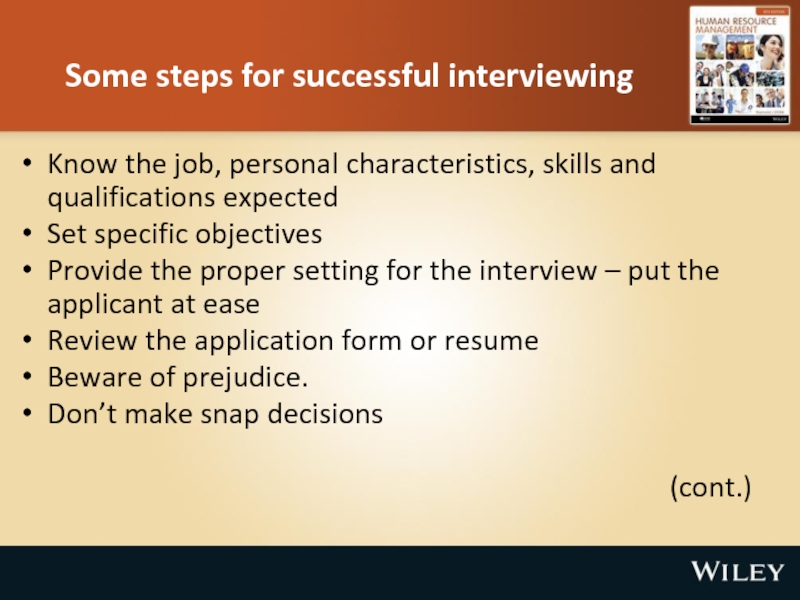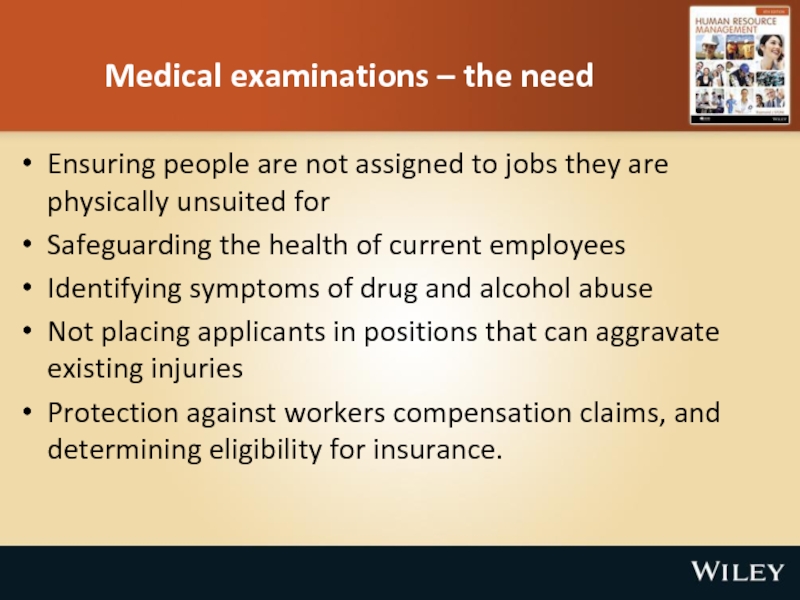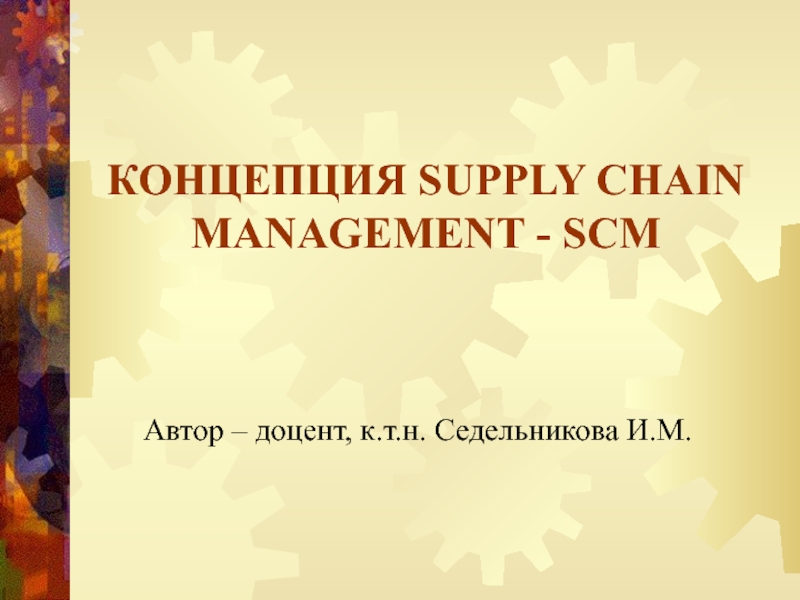- Главная
- Разное
- Дизайн
- Бизнес и предпринимательство
- Аналитика
- Образование
- Развлечения
- Красота и здоровье
- Финансы
- Государство
- Путешествия
- Спорт
- Недвижимость
- Армия
- Графика
- Культурология
- Еда и кулинария
- Лингвистика
- Английский язык
- Астрономия
- Алгебра
- Биология
- География
- Детские презентации
- Информатика
- История
- Литература
- Маркетинг
- Математика
- Медицина
- Менеджмент
- Музыка
- МХК
- Немецкий язык
- ОБЖ
- Обществознание
- Окружающий мир
- Педагогика
- Русский язык
- Технология
- Физика
- Философия
- Химия
- Шаблоны, картинки для презентаций
- Экология
- Экономика
- Юриспруденция
Employee selection. (Chapter 7) презентация
Содержание
- 1. Employee selection. (Chapter 7)
- 2. Learning outcomes On successful completion of this
- 3. FastFacts 79 per cent of job seekers
- 4. Strategic selection Selection The process of choosing
- 5. Candidate fit
- 6. Selection policy – some factors to consider
- 7. Validity Validity The ability of a test
- 8. Reliability Reliability The extent to which a
- 9. Steps in the selection process
- 10. Electronic applications Companies are increasingly using internet
- 11. Application forms and EEO requirements Some questions/topics
- 12. Application forms and EEO requirements (cont.) The
- 13. Tests Interest Compares interest patterns to those
- 14. Interviews Unstructured Few planned questions, more in
- 15. Research and the employment interview Interviewers biased
- 16. Research and the employment interview Interviewers more
- 17. Some steps for successful interviewing Know the
- 18. Some steps for successful interviewing (cont.) Encourage
- 19. Medical examinations – the need Ensuring people
- 20. Screening tests HIV/ AIDS All Australian defence
- 21. Some symptoms of employee drug use Deteriorating
- 22. Other selection techniques Biographical information blanks: for
- 23. The selection decision Compensatory Considering all the
- 24. Two approaches to the selection decision
- 25. Summary An organisation’s ultimate success depends on
Слайд 2Learning outcomes
On successful completion of this slide set, you will be
able to:
Explain strategic selection
Explain the need for validation of employee selection procedures
Describe major research findings on selection
Evaluate use of psychological tests in selection
Outline the factors that make for successful selection interviewing
Discuss the compensatory and successive hurdles approaches to selection.
Explain strategic selection
Explain the need for validation of employee selection procedures
Describe major research findings on selection
Evaluate use of psychological tests in selection
Outline the factors that make for successful selection interviewing
Discuss the compensatory and successive hurdles approaches to selection.
Слайд 3FastFacts
79 per cent of job seekers are ‘turned off’ by employers
who prolong selection process.
Australian employers are less likely to interview a person with a Chinese, Middle Eastern or Aboriginal name for a job (even if their CV is identical to someone with an Anglo-Saxon name).
Tall security guards were discreetly advised not to apply for a job guarding the 5ft 5in tall former French president Nicolas Sarkozy.
What are the implications of these FastFacts?
Australian employers are less likely to interview a person with a Chinese, Middle Eastern or Aboriginal name for a job (even if their CV is identical to someone with an Anglo-Saxon name).
Tall security guards were discreetly advised not to apply for a job guarding the 5ft 5in tall former French president Nicolas Sarkozy.
What are the implications of these FastFacts?
Слайд 4Strategic selection
Selection
The process of choosing the best qualified candidate/s from a
group of applicants.
Strategic selection
Linking of selection activities to organisation’s strategic business objectives and culture.
Selection criteria
Key factors in making a decision to hire or not to hire a person. May include qualifications, experience, special skills, abilities or aptitudes. They should be job-related.
Strategic selection
Linking of selection activities to organisation’s strategic business objectives and culture.
Selection criteria
Key factors in making a decision to hire or not to hire a person. May include qualifications, experience, special skills, abilities or aptitudes. They should be job-related.
Слайд 6Selection policy – some factors to consider
EEO
Quality of people
Sources of people
Management
roles
Selection techniques
Employment consultants
Industrial relations
Legal issues
Organisational strategic business objectives
Costs
Social acceptance
Selection techniques
Employment consultants
Industrial relations
Legal issues
Organisational strategic business objectives
Costs
Social acceptance
Слайд 7Validity
Validity
The ability of a test or other selection technique to measure
what it sets out to measure.
The correlation coefficient
Positive, negative, high and low
Typical range 0.20–0.50
1.0 is a perfect score
Zero is no relationship
Two basic approaches used by HR Managers:
concurrent validity and predictive validity
The correlation coefficient
Positive, negative, high and low
Typical range 0.20–0.50
1.0 is a perfect score
Zero is no relationship
Two basic approaches used by HR Managers:
concurrent validity and predictive validity
Слайд 8Reliability
Reliability
The extent to which a measure (for example a test) is
consistent and dependable.
Types
Test-retest
Split halves
Parallel forms
Types
Test-retest
Split halves
Parallel forms
Слайд 10Electronic applications
Companies are increasingly using internet technology for high-tech, graduate and
high, large volume appointments.
Social networking sites (i.e. Facebook, LinkedIn) are used as screening devices and sources of information about job applicants.
The challenge for HR managers is to make appointment decisions based on consistent and non-discriminatory information.
Social networking sites (i.e. Facebook, LinkedIn) are used as screening devices and sources of information about job applicants.
The challenge for HR managers is to make appointment decisions based on consistent and non-discriminatory information.
Слайд 11Application forms and EEO requirements
Some questions/topics not to include:
Marital status
Residency status
Ethnic
origin
Organisations
Photographs
Race or colour
Relatives
Organisations
Photographs
Race or colour
Relatives
Слайд 12Application forms and EEO requirements (cont.)
The following may be job-related in
some circumstances
Age
Gender
Religion
Military service
Physical disability
Medical information
Height and weight
Body modifications
Age
Gender
Religion
Military service
Physical disability
Medical information
Height and weight
Body modifications
Слайд 13Tests
Interest
Compares interest patterns to those of successful employees
Aptitude
Special abilities (clerical, linguistic)
Intelligence
IQ
Physical
Physical
characteristics
Personality
Measures personality or temperament
Personality
Measures personality or temperament
Слайд 14Interviews
Unstructured
Few planned questions, more in depth
Structured
Uses predetermined checklist of questions
Behavioural
Past behaviour
as the best indicator of future behaviour
Panel
Group
Video
Panel
Group
Video
Слайд 15Research and the employment interview
Interviewers biased against both men and women
when they apply for atypical gender jobs
When the number of female or older candidates are 25% or less of total applicants, they will be evaluated less favourably.
Interviewers develop stereotypes of a good applicant, and select those that match stereotype.
Being disabled has a positive impact on qualified candidates, but negative impact on unqualified.
Unfavourable info. outweighs favourable info.
When the number of female or older candidates are 25% or less of total applicants, they will be evaluated less favourably.
Interviewers develop stereotypes of a good applicant, and select those that match stereotype.
Being disabled has a positive impact on qualified candidates, but negative impact on unqualified.
Unfavourable info. outweighs favourable info.
Слайд 16Research and the employment interview
Interviewers more lenient in evaluating a man
who is interviewed after a woman than a woman who follows a man.
Interviewers are more likely to change their initial opinion from positive to negative than vice versa.
Interviewers post-interview ratings are highly related to pre-interview impressions.
Candidates judged to be attractive and/or appropriately groomed are more highly evaluated. Less attractive female applicants are especially disadvantaged.
Interviewers are more likely to change their initial opinion from positive to negative than vice versa.
Interviewers post-interview ratings are highly related to pre-interview impressions.
Candidates judged to be attractive and/or appropriately groomed are more highly evaluated. Less attractive female applicants are especially disadvantaged.
Слайд 17Some steps for successful interviewing
Know the job, personal characteristics, skills and
qualifications expected
Set specific objectives
Provide the proper setting for the interview – put the applicant at ease
Review the application form or resume
Beware of prejudice.
Don’t make snap decisions
(cont.)
Set specific objectives
Provide the proper setting for the interview – put the applicant at ease
Review the application form or resume
Beware of prejudice.
Don’t make snap decisions
(cont.)
Слайд 18Some steps for successful interviewing (cont.)
Encourage the applicant to do most
of the talking, but the interviewer must still keep control of the interview
Explain the job
Close the interview
Write-up the interview properly
Check references and evaluate the whole process.
Explain the job
Close the interview
Write-up the interview properly
Check references and evaluate the whole process.
Слайд 19Medical examinations – the need
Ensuring people are not assigned to jobs
they are physically unsuited for
Safeguarding the health of current employees
Identifying symptoms of drug and alcohol abuse
Not placing applicants in positions that can aggravate existing injuries
Protection against workers compensation claims, and determining eligibility for insurance.
Safeguarding the health of current employees
Identifying symptoms of drug and alcohol abuse
Not placing applicants in positions that can aggravate existing injuries
Protection against workers compensation claims, and determining eligibility for insurance.
Слайд 20Screening tests
HIV/ AIDS
All Australian defence recruits are tested. Army also has
bans on recruits with diabetes and gout.
China, South Korea and Singapore require an AIDS test before granting work permits to Australians.
Substance abuse
Drug and alcohol
Genetic
Whether someone is genetically susceptible to certain diseases
China, South Korea and Singapore require an AIDS test before granting work permits to Australians.
Substance abuse
Drug and alcohol
Genetic
Whether someone is genetically susceptible to certain diseases
Слайд 21Some symptoms of employee drug use
Deteriorating productivity
Inappropriate or angry interactions
Frequent absence
or lateness
Continuous rapid or wandering speech
Drowsiness or frequent breaks
Changes in productivity after lunch
Occasional, unpredictable flashes of performance
Accidents, errors, carelessness or sloppy work
Regularly borrowing money from colleagues
Continuous rapid or wandering speech
Drowsiness or frequent breaks
Changes in productivity after lunch
Occasional, unpredictable flashes of performance
Accidents, errors, carelessness or sloppy work
Regularly borrowing money from colleagues
Слайд 22Other selection techniques
Biographical information blanks: for example: attitudes, hobbies, sports, club
membership, years of education, health, early life experiences, investments, sales experiences.
Computer screening: Screening via resume scanning.
Polygraph: Lie detector
Honesty: Evaluate honesty and integrity
Graphology: Handwriting analysis
What issues can you identify with these?
Computer screening: Screening via resume scanning.
Polygraph: Lie detector
Honesty: Evaluate honesty and integrity
Graphology: Handwriting analysis
What issues can you identify with these?
Слайд 23The selection decision
Compensatory
Considering all the selection data (favourable and unfavourable) before
a selection decision is made.
Hurdles
Involves the screening out of candidates at each stage of the selection process.
Hurdles
Involves the screening out of candidates at each stage of the selection process.
Слайд 25Summary
An organisation’s ultimate success depends on the best applicants being selected.
Jobs
and people must be matched correctly.
Selections training is very important.
HR Managers have a key role in educating others in valid and reliable processes.
Selections training is very important.
HR Managers have a key role in educating others in valid and reliable processes.































